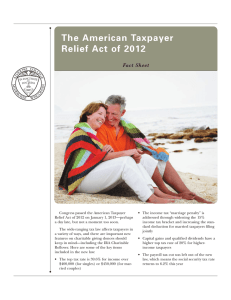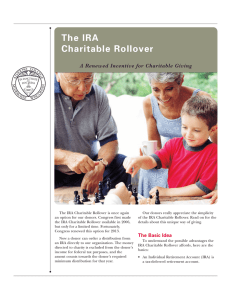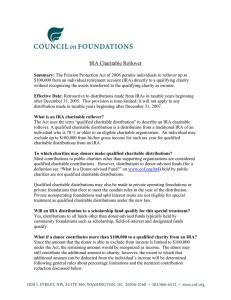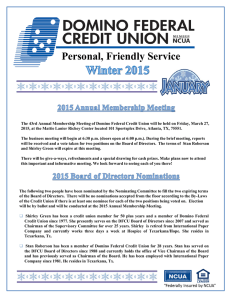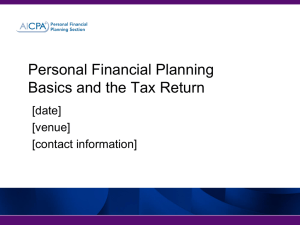Fiscal Cliff presentation November 2012
advertisement
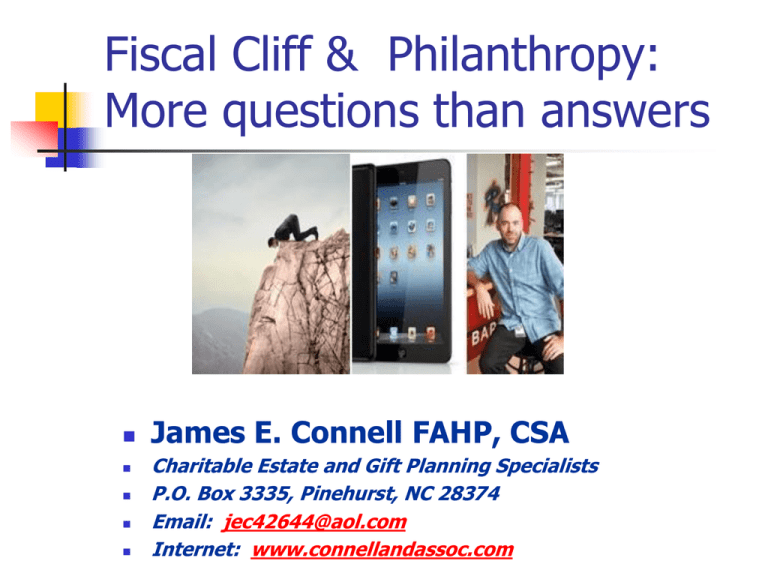
Fiscal Cliff & Philanthropy: More questions than answers James E. Connell FAHP, CSA Charitable Estate and Gift Planning Specialists P.O. Box 3335, Pinehurst, NC 28374 Email: jec42644@aol.com Internet: www.connellandassoc.com Looking back: Giving by Income 2007-2009 Cash gifts fell 9.7% while security and noncash gifts declined 46% 90% of the decline in giving from 2007 - 2009 can be traced to donors with incomes of $200,000+ Under $200,000 reduced their giving by 4.3% $100,000 to $200,000 incomes reduce their giving by >.05% What Drives Major and Campaign Donors to Give Wealthy Donor Giving Forecast How Much You Have to Make to be in the Top 50% of Earners Source: IRS, Statistics of Income Division, July 2011 The income thresholds are for the amount of AGI on a return, not per taxpayer. --Taxes on the 1% could rise and average of $121,000. --Top quintile will owe an additional $1,141 Fiscal Cliff Middle & Top Income Impact DOWN FOR ALL - The top 1% of taxpayers paid an average tax rate (i.e., federal income taxes paid as a percentage of adjusted gross income) of 34.5% in 1980, but only paid 24.0% in 2009 (the latest year that data is available). The bottom 50% of taxpayers paid an average tax rate of 6.1% in 1980, but only paid 1.8% in 2009 (source: IRS) Tax Revenue Increases 2013 to 2022 Source: Committee for Responsible Federal Budget (CRFB) Nonprofit sector could lose $5.6 Billion per year in charitable giving if the charitable deduction is cut. Higher income taxpayers account for the majority of individual giving. Taxpayers with $100,000 in 2008 provided 58% of charitable giving Fiscal Cliff & Philanthropy: More questions than answers Fiscal Cliff & Philanthropy: More questions than answers Three Federal Estate Tax Options Fiscal Cliff & Philanthropy: More questions than answers Congressional Budget Office and Fiscal Cliff Tax revenue 2013 to 2022 Fiscal Cliff & Philanthropy: More questions than answers Upper income clients may want to consider shifting income from 2013 to 2012 Sell appreciated assets before tax increase Clients over age 70 ½ might consider taking withdrawals in excess of their RMD Avoid the 3.8% Medicare surtax on investments Convert excess of regular distributions to Roth IRA Increase charitable gift deductions Consider a Non-Grantor Charitable Lead Annuity Trust to reduce estate taxes Charity and Fiscal Cliff: Give today or wait until 2013 Give in 2012 Give in 2013 Difference $10,000 $10,000 $0 Tax savings 28% in 2012 36% in 2013 $2,800 $3,600 $800 Net cost of gift $7,200 $6,400 $800 $0 $2,800 $2,800 $7,200 $9,200 $2,000 Value Taxes paid in 2012 Net cost of gift A Guide to IRA Charitable Rollovers Senate Finance Committee approved for 2012* Part of Tax Extender Act IRA account owners 70 ½ or older may make a direct transfer to charity up to $100,000 per year Amount received in IRA gifts Donor profiles of Various Size Convenience donor Standard deduction donor Generous donor Major donor Social security donor *Family and Business Tax Cut Certainty Act of 2012 (Source: PPP survey 2009) A Guide to IRA Charitable Rollovers A Guide to IRA Charitable Rollovers Allows for IRA rollovers to charity Charity must be eligible Individual must be 70 ½ or older on the date of contribution Qualified Charitable Distribution will qualify for the Required Minimum Distribution requirements of IRA $100,000 limit Both regular IRA accounts and Roth IRA accounts are eligible, IRA check books $200,000 from couple with separate accounts Transfers from other pensions and profit sharing plans, i.e. Keogh, 401k, 403b, etc., are not allowed Possible to rollover above accounts to IRA if plan and time permit A Guide to IRA Charitable Rollovers Donor Profile – Non-Itemizers May be donors with modest IRA account balances, but sufficient retirement income from personal investments and tax-exempt accounts Taking MRD may not significantly increase their lifestyle Do not have significant tax deductions State and local income taxes Interest expenses Medical expenses Charitable deductions So the standard deduction applies (2012), over 65 Married/Joint - $13,050 one / $14,200 two Single - $7,400 Head of household - $10,150 Wealth and Age Matrix
